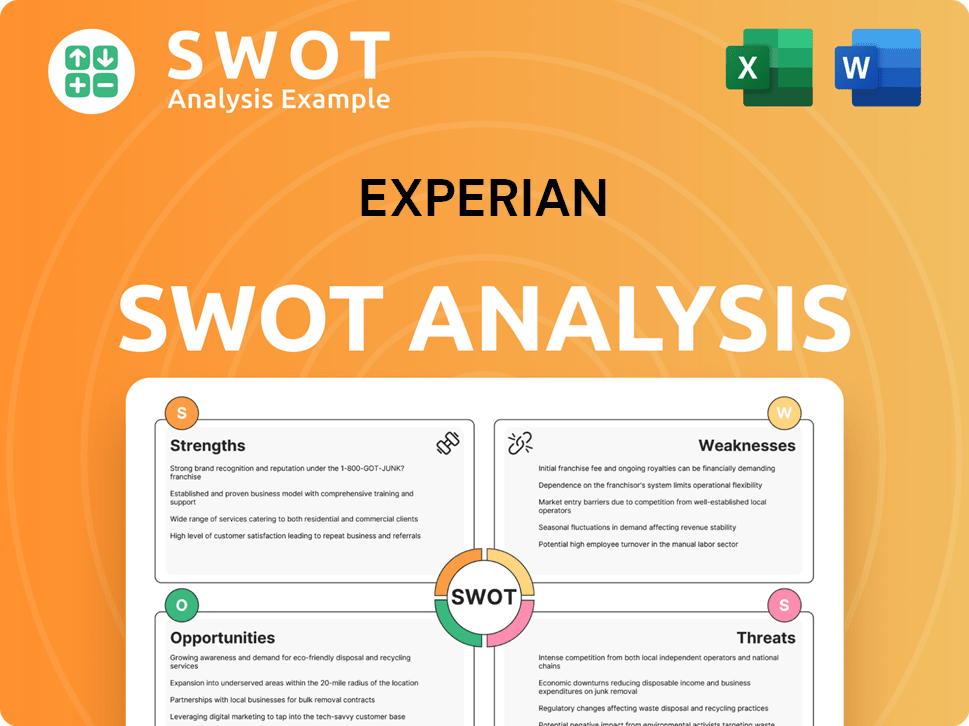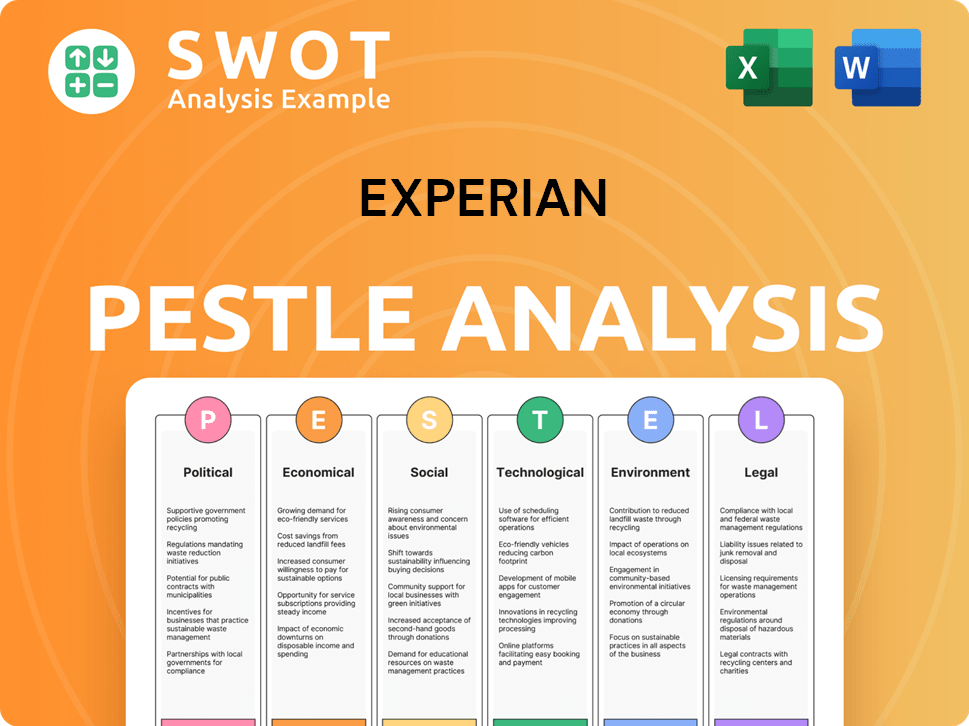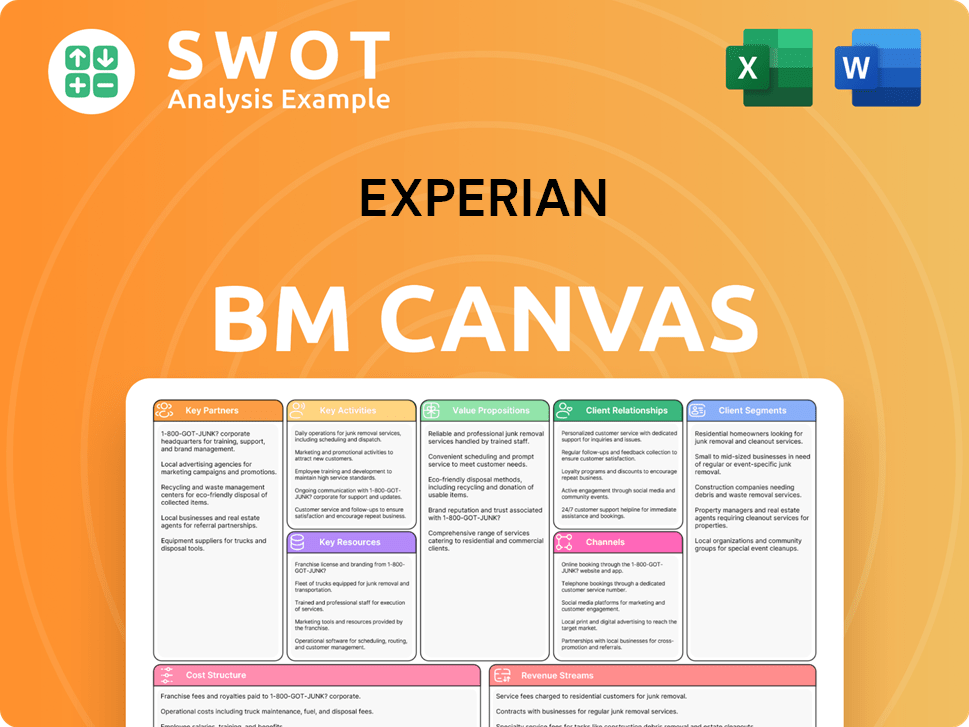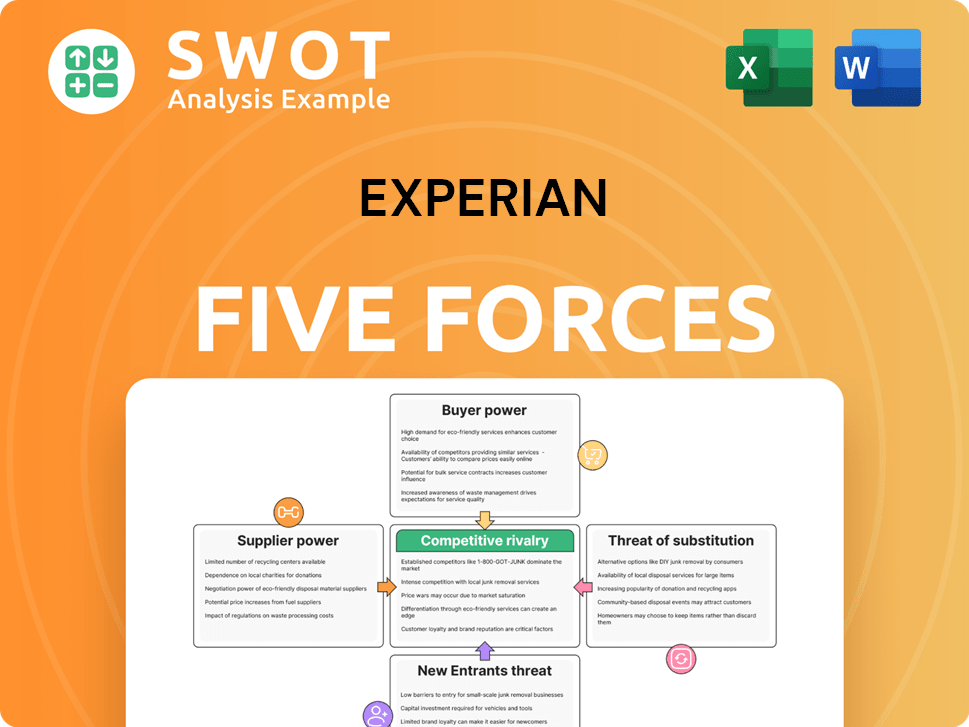Experian Bundle
Who Really Controls Experian?
Ever wondered who pulls the strings at Experian, the global data giant? Understanding Experian SWOT Analysis is key to grasping its market position. Knowing the Experian ownership structure unlocks insights into its strategic direction and future prospects. This exploration dives deep into the forces shaping this industry leader.

Unraveling who owns Experian is essential for anyone seeking to understand the company's trajectory. From its roots as a humble association to its current status as Experian PLC, a publicly traded entity, the evolution of its ownership provides a fascinating case study. This analysis will explore the major shareholders and the influences that shape Experian's credit bureau operations and its relationship with the financial world.
Who Founded Experian?
The story of Experian's ownership begins in 1826 with the United Association of Provident Societies in Nottingham, England. This early entity, formed by local businesses, aimed to share credit information to manage risk. This cooperative model set the stage for the global credit reporting agency we know today, but its initial ownership structure differed significantly from modern corporate models.
Tracing the exact founders and their specific equity stakes from this early period is challenging due to the nature of the organization and the lack of detailed public records. Instead, the focus was on collective participation among its members, who shared the goal of managing credit risk. This collaborative approach contrasts with the concept of a single, dominant founder holding a significant stake.
Over time, the organization evolved, transitioning through various phases. These included becoming British Debt Services in 1923 and later being acquired by Great Universal Stores (GUS plc) in 1968. During these transitions, the ownership shifted from a more localized, cooperative model to being integrated within a larger retail conglomerate. This shift meant that ownership effectively resided with GUS plc, rather than individual founders retaining substantial stakes. The evolution of Experian's ownership reflects a journey from a collaborative, locally-focused initiative to a part of a major corporate entity.
Experian's roots trace back to 1826 with the United Association of Provident Societies in England. This entity was a collective effort by local businesses. Their primary goal was to share credit information.
The early structure emphasized a distributed ownership among its members. This cooperative approach aimed to mitigate financial risks. The focus was on shared responsibility rather than individual founder stakes.
Experian's ownership changed over time, including the acquisition by GUS plc in 1968. The ownership transitioned from a local cooperative to being part of a larger retail conglomerate. This evolution shaped the company's ownership structure.
The concept of 'founder stakes' is less applicable to Experian's early history. The initial formation predates modern corporate structures. The growth was largely through acquisitions and mergers.
Experian's origins highlight a collaborative effort to manage credit risk. The ownership structure evolved significantly over time. The company's history shows a shift from a cooperative model to a corporate structure.
Today, Experian operates as a public company. The ownership is distributed among institutional investors and the public. The company's structure reflects its growth and evolution.
Understanding the history of Experian ownership provides context for its current structure. The company's journey from a cooperative to a global credit bureau highlights significant changes. For more details on its business model, you can read about the Revenue Streams & Business Model of Experian.
- The initial ownership was distributed among members of the United Association of Provident Societies.
- GUS plc acquired Experian, changing the ownership structure.
- Today, Experian PLC is a public company with a diverse shareholder base.
- The evolution of Experian ownership reflects its growth and adaptation.
Experian SWOT Analysis
- Complete SWOT Breakdown
- Fully Customizable
- Editable in Excel & Word
- Professional Formatting
- Investor-Ready Format

How Has Experian’s Ownership Changed Over Time?
The evolution of Experian ownership is marked by a significant shift in October 2006. This was when it demerged from GUS plc and was listed on the London Stock Exchange. This initial public offering (IPO) was a turning point, transforming Experian from a subsidiary into an independent, publicly traded entity. The IPO's market capitalization reflected its established presence in the credit services market. Since then, its ownership has primarily been characterized by institutional investment.
The Experian ownership structure explained reveals a company largely held by institutional investors. The shift from a parent company to independent status has allowed for a more diverse and potentially more volatile shareholder base, influenced by market performance and investment strategies.
| Event | Date | Impact on Ownership |
|---|---|---|
| Demerger from GUS plc | October 2006 | Became an independent, publicly traded company. |
| IPO on London Stock Exchange | October 2006 | Transitioned from a subsidiary to a publicly listed entity. |
| Ongoing Institutional Investment | 2006-Present | Ownership dominated by institutional investors like BlackRock and Vanguard. |
As of early 2025, Experian PLC's major stakeholders are primarily large institutional investors. For example, BlackRock, Inc. holds a significant stake, owning approximately 5.86% of the company as of May 2024. Other prominent institutional shareholders include The Vanguard Group, Inc., with about 3.39% of shares, and Capital Research Global Investors, holding around 3.01%. These figures highlight the typical ownership profile of a FTSE 100 company, where a substantial portion of shares is held by investment funds on behalf of their clients. Other notable institutional investors include Norges Bank Investment Management, and State Street Global Advisors. The collective holdings of these institutional investors significantly influence company strategy and governance through their voting power. Changes in these institutional holdings can impact the company's stock performance and strategic direction. For example, in May 2024, BlackRock, Inc. increased its holding in Experian. If you want to learn more about the Experian credit bureau, you can read about the Target Market of Experian.
Experian's ownership transitioned from a parent company to institutional investors after its IPO in 2006.
- BlackRock, The Vanguard Group, and Capital Research Global Investors are among the major shareholders.
- Institutional investors significantly influence the company's strategic direction.
- Changes in these holdings can affect stock performance.
- Understanding Experian's ownership is crucial for investors and stakeholders.
Experian PESTLE Analysis
- Covers All 6 PESTLE Categories
- No Research Needed – Save Hours of Work
- Built by Experts, Trusted by Consultants
- Instant Download, Ready to Use
- 100% Editable, Fully Customizable

Who Sits on Experian’s Board?
The Board of Directors of Experian PLC, as of early 2025, is composed of a mix of executive, non-executive, and independent directors. The board's role is pivotal in overseeing the company's governance and representing the interests of all shareholders. Although specific individuals representing major shareholders aren't explicitly listed as board members in a direct 'shareholder representative' capacity, the non-executive directors are expected to provide independent oversight and challenge the executive team.
The board's composition and decisions are accountable to a broad base of shareholders. The board's structure is designed to ensure independent oversight and strategic guidance, reflecting the company's commitment to good corporate governance. The board's decisions are continuously under scrutiny by influential shareholders.
| Board Member | Title | Notes |
|---|---|---|
| Brian Cassin | Chief Executive Officer | |
| Lorne Abony | Non-Executive Director | |
| Caroline Silver | Non-Executive Director |
The voting structure at Experian PLC follows a one-share-one-vote principle, which is standard for most publicly listed companies. This means that each ordinary share carries one vote, ensuring that voting power is directly proportional to the number of shares held. There are no indications of dual-class shares or special voting rights that would grant disproportionate control to specific entities. This structure promotes a level playing field among shareholders. Experian's governance and strategic decisions are continuously under scrutiny by these influential shareholders. Understanding Competitors Landscape of Experian is also crucial in this context.
Experian's Board of Directors includes a mix of executive and non-executive directors. The voting structure is one-share-one-vote, ensuring equitable shareholder power.
- The board oversees governance and represents all shareholders.
- Non-executive directors provide independent oversight.
- Major institutional investors hold significant influence.
- The company's governance is under continuous scrutiny.
Experian Business Model Canvas
- Complete 9-Block Business Model Canvas
- Effortlessly Communicate Your Business Strategy
- Investor-Ready BMC Format
- 100% Editable and Customizable
- Clear and Structured Layout

What Recent Changes Have Shaped Experian’s Ownership Landscape?
Over the past few years, the Experian ownership structure has remained relatively stable, aligning with the trend of increasing institutional investment in large-cap companies. Share buybacks have been a common method to return value to shareholders, but there haven't been any major shifts like a privatization or a significant change in the ownership landscape. The company's focus remains on its financial performance and strategic growth, rather than on substantial ownership changes.
Industry trends indicate a rise in institutional investment, with passive funds gaining a larger share of the market. This is reflected in Experian's shareholder base, where large asset managers like BlackRock and Vanguard consistently appear as top holders. Founder dilution occurred earlier in Experian's history as it transitioned to a publicly traded entity. For more information about the company's growth, you can read the Growth Strategy of Experian.
| Shareholder | Percentage of Ownership (Approximate) | Notes (as of Early 2025) |
|---|---|---|
| BlackRock | Around 8-10% | A significant institutional investor, reflecting the trend of institutional ownership. |
| Vanguard | Around 7-9% | Another major institutional investor, demonstrating the influence of passive funds. |
| Other Institutional Investors | Remaining percentage | Includes various other asset managers, pension funds, and investment firms. |
Experian, as of early 2025, continues to operate as a publicly traded company with a robust, institutionally-owned structure. The ownership trends mirror broader movements in global capital markets, with no major changes expected in the near future. The focus remains on financial performance and strategic growth.
Experian is primarily owned by institutional investors. Major shareholders include BlackRock and Vanguard, reflecting the broader trend of institutional ownership in large-cap companies.
Yes, Experian is a publicly traded company, with its shares listed on the London Stock Exchange under the symbol EXPN.
The major shareholders of Experian are primarily institutional investors such as BlackRock and Vanguard, who hold significant percentages of the company's shares.
Experian's ownership structure is characterized by a high degree of institutional ownership, with a significant portion of shares held by large asset management firms and other institutional investors.
Experian Porter's Five Forces Analysis
- Covers All 5 Competitive Forces in Detail
- Structured for Consultants, Students, and Founders
- 100% Editable in Microsoft Word & Excel
- Instant Digital Download – Use Immediately
- Compatible with Mac & PC – Fully Unlocked

Related Blogs
- What are Mission Vision & Core Values of Experian Company?
- What is Competitive Landscape of Experian Company?
- What is Growth Strategy and Future Prospects of Experian Company?
- How Does Experian Company Work?
- What is Sales and Marketing Strategy of Experian Company?
- What is Brief History of Experian Company?
- What is Customer Demographics and Target Market of Experian Company?
Disclaimer
All information, articles, and product details provided on this website are for general informational and educational purposes only. We do not claim any ownership over, nor do we intend to infringe upon, any trademarks, copyrights, logos, brand names, or other intellectual property mentioned or depicted on this site. Such intellectual property remains the property of its respective owners, and any references here are made solely for identification or informational purposes, without implying any affiliation, endorsement, or partnership.
We make no representations or warranties, express or implied, regarding the accuracy, completeness, or suitability of any content or products presented. Nothing on this website should be construed as legal, tax, investment, financial, medical, or other professional advice. In addition, no part of this site—including articles or product references—constitutes a solicitation, recommendation, endorsement, advertisement, or offer to buy or sell any securities, franchises, or other financial instruments, particularly in jurisdictions where such activity would be unlawful.
All content is of a general nature and may not address the specific circumstances of any individual or entity. It is not a substitute for professional advice or services. Any actions you take based on the information provided here are strictly at your own risk. You accept full responsibility for any decisions or outcomes arising from your use of this website and agree to release us from any liability in connection with your use of, or reliance upon, the content or products found herein.